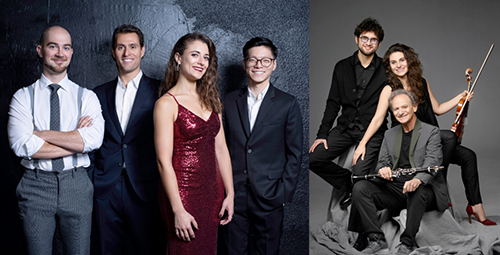by Mike Telin

“Many of us at Cleveland Chamber Music Society have gone to a lot of ChamberFest concerts over the years and admired their exceptional quality and creative programming,” Steve Somach, the CCMS director of programming, said by telephone. “We have commented amongst ourselves that when we attend those concerts, there are so many unfamiliar faces.”
During a separate conversation these sentiments and observations were echoed by Franklin Cohen, one of ChamberFest Cleveland’s artistic directors. “I’ve always loved going to CCMS concerts,” he said, adding that it is a different audience.
After some discussion, the two organizations decided to compare their respective mailing lists, and they were met with a surprising discovery — there was very little duplication. “It became apparent that having a collaborative event would be a great way for Cleveland-area chamber music lovers to be introduced to both organizations,” Somach said.
On Tuesday, April 5 at 7:30 pm at the Maltz Performing Arts Center, ChamberFest and the Chamber Music Society will present their first such collaboration. “For the Love of Chamber Music” will feature performances by the Dover Quartet — Joel Link and Bryan Lee (violins), Milena Pajaro-van de Stadt (viola), Camden Shaw (cello) — and ChamberFest artistic directors Franklin Cohen (clarinet), Diana Cohen (violin), and Roman Rabinovich (piano). The program will include Mozart’s Kegelstatt Trio, Ravel’s String Quartet, and Chausson’s Concerto for Violin, Piano and String Quartet. Tickets for in-person and livestream are available online.
Somach and Franklin Cohen agreed that the logical artistic link between the two organizations was the Dover Quartet, whom the Chamber Music Society has presented on three occasions. And whose violist, Milena Pajaro-van de Stadt, was part of ChamberFest in 2019.
“I’m absolutely thrilled to be sharing the concert with the Dover Quartet,” Cohen said. “I’ve been a great admirer of them for some time.”
The clarinetist also looks forward to reuniting with Pajaro-van de Stadt. “I first met Milena at a music festival near Philadelphia,” he said. “Diana knew her and invited her to play some chamber music. We read through the Mozart and the Weber quintets and probably the Brahms too,” he recalled. “I thought she was the best thing since sliced bread.”
For Cohen, this concert is also about making music with his personal and musical family — something that is important to him. “My late wife Lynette was a musician, and both of our children became musicians. Then Diana married Roman, who is a musician. Milena is part of the ChamberFest family and now we have this concert with the Dover — I’m just a lucky guy.”
Cohen said he looks forward to hearing the Dover’s performance of the Ravel. “And to hear Diana and Roman play the Chausson with them is going to be a thrill,” he added. “And I’m playing the Mozart with one of my favorite violists on the planet.”
Given the number of times Cohen has performed the Kegelstatt Trio, does he ever get tired of playing it? “You know, I don’t,” he said. “In fact, I don’t get tired of playing any Mozart.”
Cohen said that the piece holds a special place in his heart. He recalled that the first time he played the trio was with Rudolph Serkin and former Cleveland Orchestra principal viola Robert Vernon. “It was my first assignment during my first year at Marlboro. I was really nervous because I was still sort of a kid and so was Bob, but he was the famous director of the Festival. But when Serkin started to play, Bob and I looked at each other and thought, so that’s what it’s supposed to sound like.”
The German word Kegelstatt means ‘a place where skittles are played,’ and while there is evidence that Mozart played the game, there is nothing to suggest that the composer gave that nickname to the K. 498 trio. Still, it’s entertaining to contemplate what the connection might have meant.
“I remember being in the locker room at Severance practicing a couple passages from the piece,” Cohen said, “when a former member of the viola section came up to me and said, ‘Frank, do you know why they call it the Kegelstatt?’ I said sure, the story goes that Mozart was observing a game of skittles while he was sketching the piece. He said, ‘You know, there’s a much deeper history behind this.’”
The piece begins with a forte chord followed by a quick ornament and a slower descending motive. Cohen recalled what the violist told him: “If you think about it, Mozart was watching bowling, which at the time had nine pins,” the clarinetist said. “So there’s the crash of the ball — the forte chord — then the pins falling over, the first ones falling quickly and the last ones more slowly.”
Cohen found the story to be completely astounding. “Now it makes sense,” he said. “Mozart is watching the game and decides to make a little motif out of it and build on that. So now I feel like Mozart is watching us play the game.”
Published on ClevelandClassical.com March 25, 2022.
Click here for a printable copy of this article



